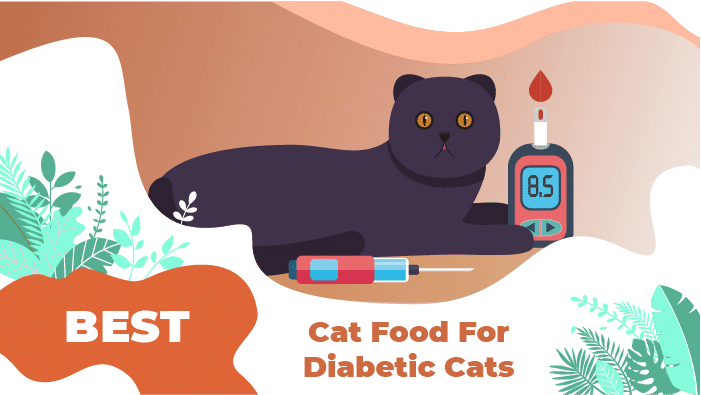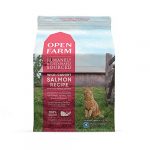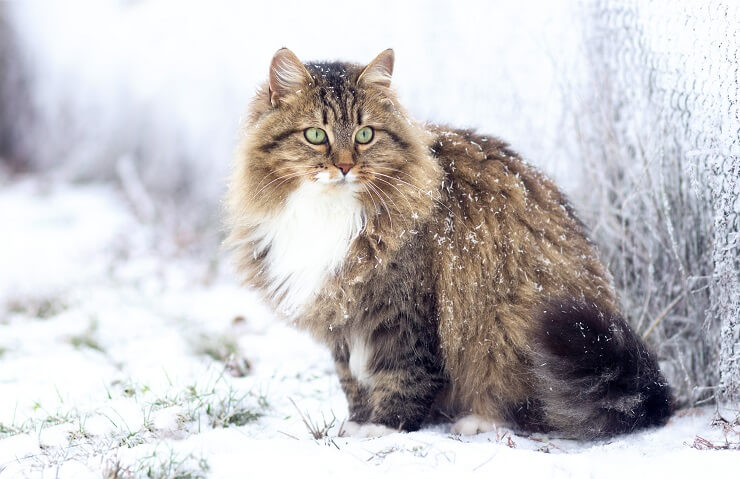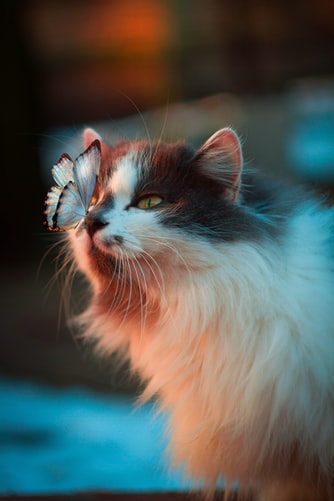The 7 Best Cat Food For Diabetic Cats
This page contains affiliate links. We may earn money or products from the companies mentioned in this post through our independently chosen links, which earn us a commission.
According to veterinarians, more and more cats today have diabetes mellitus. With diabetes mellitus, a cat is unable to produce or respond appropriately to the hormone insulin. When this happens, the body will have increased levels of glucose.
Glucose provides the main source of energy for the body. In Type I diabetes, glucose levels are high because the body isn’t producing enough insulin.
In Type II diabetes, glucose levels are high because the cells in the body aren’t responding appropriately to the insulin.
Cats usually have Type II diabetes. (Dogs, by contrast, usually have Type I diabetes.) Diabetic cats do require special diets. We can help you choose the best cat food for diabetic cats.
It’s estimated that between 0.2 and 1 percent of pet cats today have diabetes but many veterinary sources believe that the condition is under-diagnosed.
Compare Best Cat Food For Diabetic Cats
|
Premium Choice
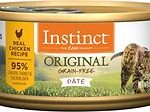
3. Instinct Original Grain-Free Pate Real Chicken Recipe Wet Canned Cat Food |
Most Popular
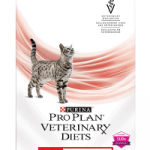
4. Purina Pro Plan Veterinary Diets DM Dietetic Management Formula Dry Cat Food |
Best Budget
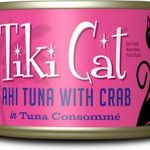
5. Tiki Cat Hana Grill Ahi Tuna with Crab in Tuna Consomme Grain-Free Canned Cat Food |
Best For Sensitive Stomach

6. Weruva Cats in the Kitchen Goldie Lox Chicken & Salmon Au Jus Grain-Free Canned Cat Food |
Best For Kittens
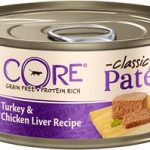
7. Wellness CORE Natural Grain Free Turkey & Chicken Liver Pate Canned Kitten Food |
||
|
Protein
37% Min |
Protein
21.2% Min |
Protein
11.0% Min |
Protein
51% Min |
Protein
18.4% Min |
Protein
10% Min |
Protein
12% Min |
|
Fat
18% Min |
Fat
8.05% Min |
Fat
7.5% Min |
Fat
15% Min |
Fat
2.3.0% Min |
Fat
1.6% Min |
Fat
7.5% Min |
|
Fiber
3% Max |
Fiber
0.4% Max |
Fiber
3% Max |
Fiber
3% Max |
Fiber
0% Max |
Fiber
0.5% Max |
Fiber
1% Max |
|
Moisture
10% Max |
Moisture
66.1% Max |
Moisture
78% Max |
Moisture
12% Max |
Moisture
77% Max |
Moisture
87% Max |
Moisture
78% Max |
|
Caloric Content
3840 kcal me/kg, 470 kcal me/cup |
Caloric Content
550 kcal/package |
Caloric Content
105 kcal/3 oz can |
Caloric Content
592 kcal/cup |
Caloric Content
160 kcal/6 oz can |
Caloric Content
111 kcal/6-oz can |
Caloric Content
199 kcal/5.5-oz can |
|
Food Type
Dry |
Food Type
|
Food Type
|
Food Type
|
Food Type
|
Food Type
|
Food Type
|
Diabetes is not usually cured in cats but it can be successfully managed through diet and working with your veterinarian.
Feeding your cat a prescription cat food made for diabetic cats or a food that is suitable for a cat with diabetes is one of the most important parts of controlling blood glucose levels.
These foods can also help control your diabetic cat’s weight.
The 7 Best Foods For Diabetic Cats Reviewed
Some diabetic cats may require a prescription or veterinary diet. We suggest that you consult with your veterinarian about feeding your cat.
If your cat is allowed to eat a good cat food that is high in protein, moderate in fat, and low in carbohydrates, we recommend the following cat foods for diabetic cats.
Open Farm Wild-Caught Salmon Grain-Free Dry Cat Food
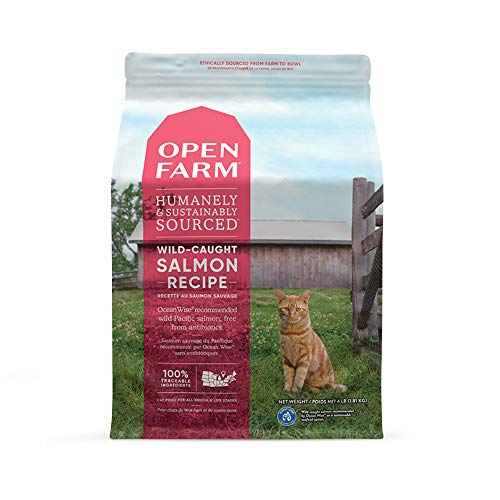
Product Info
- Protein: 37% Min
- Fat: 18% Min
- Fiber: 3% Max
- Moisture: 10% Max
- Caloric Content: 3840 kcal me/kg, 470 kcal me/cup
- Food Type: Dry
This all life stage food has a blend of wild pacific salmon and ocean whitefish meal that most cats will love. It has 37 percent crude protein, 18 percent crude fat, and 3 percent fiber, with very low carbohydrates.
37 percent of the calories come from protein, 44 percent of calories come from fat, and 18 percent of calories come from carbohydrates.
The food also has 8 percent moisture can help keep your cat hydrated. We think this would be a good fresh food choice for a diabetic cat. Open Farm also has a veterinary nutritionist on staff.
Smalls Fresh Minced Chicken Cat Food
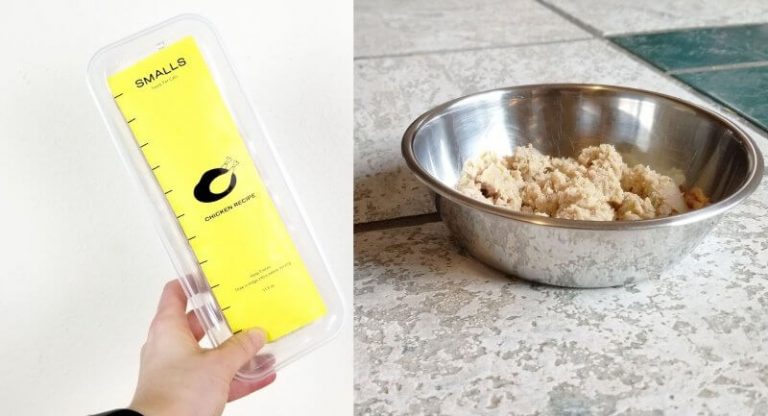
Product Info
- Protein: 21.2% Min
- Fat: 8.05% Min
- Fiber: 0.4% Max
- Moisture: 66.1% Max
- Caloric Content: 550 kcal/package
Choose from a variety of wet food formulas including minced foods and pates, made with real animal proteins like chicken, turkey, and beef. Smalls also offers a selection of freeze-dried food and treats, all of which can be delivered right to your door in convenient monthly shipments.
If you’re looking for a nutritious, highly digestible cat food made with ingredients you can feel good about, Smalls is a brand worth considering.
Instinct Original Grain-Free Pate Real Chicken Recipe Wet Canned Cat Food
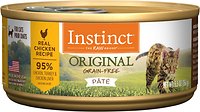
Product Info
- Protein: 11.0% Min
- Fat: 7.5% Min
- Fiber: 3% Max
- Moisture: 78% Max
- Caloric Content: 105 kcal/3 oz can
It has 11 percent protein and just 1.82 percent carbohydrates, with 7.5 percent fat, 3 percent fiber, and 78 percent moisture.
It’s made up of 95 percent chicken, turkey, and chicken liver. The food has no grain, potato, corn, wheat, soy, or artificial colors or preservatives. Made with a pâté texture.
Purina Pro Plan Veterinary Diets DM Dietetic Management Formula Dry Cat Food
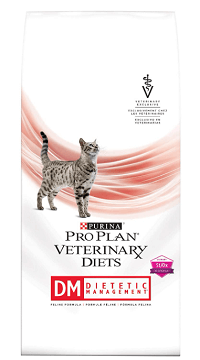
Product Info
- Protein: 51% Min
- Fat: 15% Min
- Fiber: 3% Max
- Moisture: 12% Max
- Caloric Content: 592 kcal/cup
The canned food has 9.5 percent crude protein, 4 percent crude fat, 2 percent crude fiber, and 78 percent moisture. Also available as a dry cat food. Prescription.
Tiki Cat Hana Grill Ahi Tuna with Crab in Tuna Consomme Grain-Free Canned Cat Food
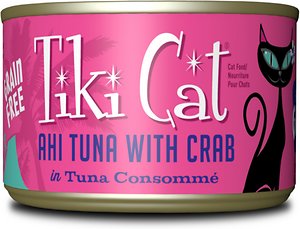
Product Info
- Protein: 18.4% Min
- Fat: 2.3.0% Min
- Fiber: 0% Max
- Moisture: 77% Max
- Caloric Content: 160 kcal/6 oz can
The first three ingredients are tuna, tuna broth, and crab. This food has 75 kcal per 2.8 ounce can. It’s typical of Tiki Cat foods.
They have lots of other fish-based canned foods as well as a line of similar chicken-based foods.
They also have some good variety packs. Their After Dark line includes organ meats. We think Tiki Cat’s higher protein and low carb canned foods would be a good choice for diabetic cats.
Wellness CORE Natural Grain Free Turkey & Chicken Liver Pate Canned Kitten Food
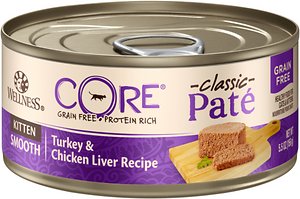
Product Info
- Protein: 12% Min
- Fat: 7.5% Min
- Fiber: 1% Max
- Moisture: 78% Max
- Caloric Content: 199 kcal/5.5-oz can
This food has 12 percent protein and less than 3 percent carbohydrates. The first ingredients are Chicken, Turkey, Chicken Broth, Chicken Liver, Chicken Meal, and Turkey Liver. It’s grain-free and gluten-free with no corn, wheat, or soy.
We think the higher protein percentage and lower carbs makes this food a food that could be good for your diabetic cat.
Weruva Cats in the Kitchen Goldie Lox Chicken & Salmon Au Jus Grain-Free Canned Cat Food
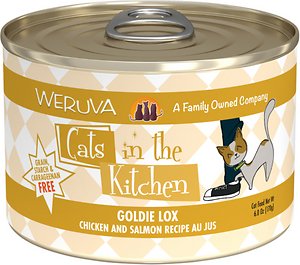
Product Info
- Protein: 10% Min
- Fat: 1.6% Min
- Fiber: 0.5% Max
- Moisture: 87% Max
- Caloric Content: 111 kcal/6-oz can
Weruva Goldie Lox features chicken and salmon. It has 11.23 percent protein, 2.1 percent fat, and 0.68 percent carbs.
It contains 59 calories in a 3.2 ounce can. (One of the nice things about Weruva is that they provide detailed nutrition information about all of their foods.)
The first ingredients in this food are Chicken Broth, Chicken (Boneless, Skinless Breast), Tuna, and Salmon. Weruva has a couple of other product lines and quite a few foods that could be good for diabetic cats.
What Are The Causes Of Diabetes In Cats?
Most people believe that more cats have diabetes today because of contemporary changes in lifestyles for cats.
More cats live indoors today than in the past. As a result, cats often don’t get enough exercise today. They may also have continuous access to food.
Even if their portions are controlled, many cat foods today, especially dry cat foods, are high in carbohydrates.
Cat obesity is a common problem today and is often a precursor to diabetes.
Eating dry cat food, which is usually high in carbohydrates, can be another reason why cats develop diabetes according to some sources.
Being overweight or obese, not getting enough exercise, and eating a diet high in carbohydrates are common risk factors for diabetes in cats but there are some other possible causes.
- Agromegaly. Agromegaly occurs when a tumor in the pituitary gland produces too much growth hormone. This results in the cat – and his organs – becoming too large. The growth hormone will eventually affect the cat’s insulin levels and result in diabetes.
- Breed disposition. Some kinds of cats are more prone to developing diabetes than others. And other breeds seem to be less likely to develop diabetes. A 2015 study, “Incidence of Diabetes Mellitus in Insured Swedish Cats in Relation to Age, Breed and Sex” examined over 500,000 cats. Burmese, Russian Blue, Norwegian Forest cats, and Abyssians had a higher likelihood of developing diabetes than other cats. Domestic Swedish cats were more likely to develop diabetes than purebred cats.
- Cushing’s disease. Cushing’s disease or hyperadrenocorticism is caused by the adrenal glands producing too much cortisol. If the cat’s body has too much cortisol it can have problems responding to insulin and lead to diabetes. This disease is rare in cats.
- Glucocorticoid medications. Cats that take certain medications such as prednisone, prednisolone, dexamethasone, or methylprednisolone for allergies, asthma, inflammatory bowel disease, or other health problems, especially at high doses, can be more prone to developing diabetes.
- Pancreatitis. Pancreatitis, often linked to eating too much fat in the diet, is another risk factor for diabetes. If your cat’s pancreas can’t produce enough insulin to maintain the proper blood sugar levels, it can lead to diabetes.
Cats that are middle-aged and senior cats are more likely to develop diabetes mellitus. Male cats are also more at risk than female cats.
Neutered male cats also have a higher risk.
Should You Feed Your Diabetic Cat A Low-carb Diet?
At one time veterinarians and researchers used to recommend cat food for diabetic cats that was high in fiber but that approach is no longer recommended.
Instead, today most sources recommend that diabetic cats should eat a diet that is high in protein and low in carbohydrates.
Most sources consider a “low-carb” diet one that contains 10 percent or less carbohydrates. Some cats may need to eat a diet that is as low as 5 percent carbs.
These percentages are usually not possible with dry cat foods but they can be achieved with other kinds of diets.
Some cat owners with diabetic cats prefer to feed a raw food diet. They believe that a raw diet is closer to the cat’s natural diet and should be healthier.
These diets are usually high in protein and have few or no carbohydrates.
These diets can work for diabetic cats but it is necessary to make sure the diet is balanced and contains all of the vitamins and minerals your cat needs.
If you intend to feed your cat a raw diet, please consult a veterinary nutritionist when planning the diet.
Fresh food diets often have many of the benefits of a raw diet but they are already formulated for your cat.
These foods are often high in protein and low in carbohydrates.
As long as the food is made by a company that works with a good veterinary nutritionist and uses good quality control measures, this kind of diet can be a good choice for a diabetic cat.
Some canned/wet cat foods are also a good cat food for diabetic cats but you do need to check the guaranteed analysis.
It’s even better if you can look at the nutrient analysis for more precise information about the breakdown of nutrients.
There are some good canned foods that are high in protein and low in carbs.
Dry foods or kibbles are the most problematic foods for diabetic cats.
Even kibbles that are comparatively low in carbohydrates tend to have more carbs than canned, fresh, or raw food diets.
Unless your cat won’t eat anything else or your veterinarian recommends a prescription dry cat food, it’s usually best to avoid kibbles for diabetic cats.
If your cat refuses to eat anything except dry food (and there are cats who just love kibble), we suggest trying to add canned or fresh food as a topper so your cat can mix it up a little.
If you’re wondering why a low carbohydrate approach is recommended for diabetic cats, it’s because carbohydrates break down into sugar in the body and sugar affects your cat’s blood sugar level.
When you feed a diet that is low in carbs your cat doesn’t need as much insulin to control his blood sugar level.
He won’t have extreme sugar spikes after eating. If he eats fewer carbohydrates it means that there is more protein and fat in his food.
Your cat’s body can metabolize these nutrients more slowly and that’s better for him.
No matter what food you feed your cat, keep in mind that you need to look for food that is high in protein with moderate fat and low carbohydates.
Some cats may need a prescription or veterinary diet, at least at first, until you can get the disease under control.
There are some other good food choices, especially in the long term. (See below.) Talk to your vet about your cat’s diet.
What To Look For When Choosing A Food For Your Diabetic Cat?
Most cat lovers know that cats are considered obligate carnivores. This means that they have to have meat in their diet.
Cats also have to have taurine which comes from muscle meat, among other sources. Taurine can also come from shellfish and fish. Cold water fish is an especially good source of taurine.
Cats also need a special form of Vitamin A. They lack the enzyme to convert regular Vitamin A into a form they can use so they must have the active form of Vitamin A that comes from animal sources.
Here’s a look at the things cats need in their diet:
- Plenty of meat protein;
- The active form of Vitamin A – retinol;
- Arachidonic acid, an essential fatty acid;
- Arginine, an amino acid;
- Linoleic acid, a fatty acid;
- Niacin, a B vitamin;
- Taurine, an amino acid;
- Moderate fat;
- Low carbohydrates.
We also suggest that you try to avoid artificial colors, flavors, and preservatives.
The minimum percentages a healthy adult cat needs in her diet are 26 percent protein and 9 percent fat. Many people prefer to feed a higher percentage of protein.
- Most sources recommend that 50 percent of your diabetic cat’s calories come from animal-based protein.
- About 40 percent of the calories should come from fat.
- 1-2 percent of calories should come from carbohydrates.
- The food should also contain plenty of moisture.
Lots of diabetic cats are overweight or obese. If your cat is overweight, talk to your veterinarian about helping your cat lose weight safely.
This can be harder to do if your cat is diabetic. Your cat needs to lose weight gradually and you have to be mindful of your cat’s blood sugar levels.
If your diabetic cat loses weight it can often make the diabetes easier to control.
In some cats that have had untreated diabetes, they may be underweight. In these cases the cats need to gain weight. Again, your veterinarian can help you with this kind of diet.
Your diabetic cat’s meals need to be timed with his insulin shots so his blood sugar levels can be managed. This means you cannot leave food sitting out for your cat to eat freely. His portions and meal times have to be controlled.
Conclusion
With more and more cats developing diabetes today, it’s not always easy to know what to feed your cat.
We hope the information here, along with the cat food suggestions, will help you choose the best cat food for your diabetic cat.
Disclaimer: This article is not a substitute for veterinary advice. Your veterinarian can provide personalized suggestions relevant to your cat’s unique situation.

